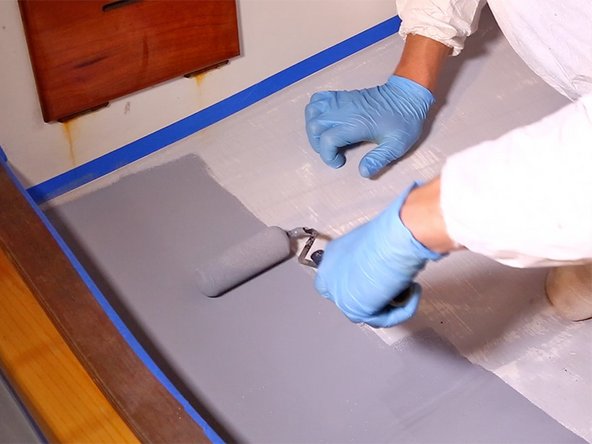Introduction
Why Is It Important To Paint My Bilge?
A clean, freshly painted bilge is easier to keep clean, and free of any odors. By keeping water, oil, and other chemicals out, TotalBoat TotalBilge epoxy bilge paint acts as a barrier that seals the surface, protecting fiberglass bilges from wicking and osmotic damage, and wood bilges from rot. A clean, attractive finish also makes it easier to pinpoint small problems like minor fuel or antifreeze leaks before they turn into costly repairs.
Tools
Video Overview
-
-
Fiberglass: Wipe the surface clean with a lint-free rag wetted with TotalBoat Dewaxer & Surface Prep. Abrade the surface with 220-grit sandpaper. Remove sanding residue then wipe clean with TotalBoat Special Brushing Thinner 100 (unless priming with TotalProtect***, you would solvent wipe with TotalBoat Dewaxer & Surface Prep).
-
***Priming Fiberglass (Optional): For a more robust undercoat on fiberglass, prime with TotalBoat TotalProtect Epoxy Barrier Coat & Primer, as directed. Allow to dry, then sand with 220-grit sandpaper, and wipe clean with TotalBoat Special Brushing Thinner 100. Allow to dry completely.
-
Wood: Wipe the wood clean with TotalBoat Special Brushing Thinner 100 to remove surface contaminants. Sand the surface with 220-grit sandpaper, and wipe the wood clean with Special Brushing Thinner 100.
-
Priming Wood (Optional): Prime with TotalBoat Topside Primer, as directed, and allow to dry. Sand lightly with 220-grit sandpaper, wipe clean with TotalBoat Special Brushing Thinner 100, and allow to dry.
-
Previously Painted Surfaces: Good Condition: Wipe the surface with TotalBoat Special Brushing Thinner 100, then prime with Topside Primer & let dry.
-
Previously Painted Surfaces: Poor Condition: Remove all existing coatings, including paints & primers. Then follow prep for Previously Painted Surfaces In Good Condition.
-
Metals: Priming is mandatory on metals. Prime with TotalBoat TotalProtect, as directed. Once cured, sand with 220-grit sandpaper, and remove sanding residue.
-
-
-
The liquid and solid components can become separated between uses. Stir thoroughly.
-
THINNING: Note that TotalBilge epoxy bilge paint is naturally thicker than most common topside paints and in certain conditions may need to be thinned for desired flow and applications.
-
IF BRUSHING/ROLLING - TotalBilge should not require thinning on fiberglass or primed surfaces. TotalBoat Special Brushing Thinner 100 can be added (5-10%) to increase flow or help extend working time in warmer conditions. The first coat on bare wood substrates should be thinned 10%.
-
IF SPRAYING - Thin TotalBilge 10-20% with xylene.
-
-
-
Apply 1-2 coats of bilge paint by brush, roller, or spay. Pay close attention to overcoating times and temperatures.
-
Application Tips:
-
Before you begin painting, make sure the weather will cooperate. Pay careful attention to paint, air, and substrate temps as well as relative humidity. Paint when conditions allow drying before dew sets in.
-
Be sure to stir the paint enough so that the high-solids material that settles on the bottom is thoroughly mixed in.
-
Thinning: If necessary, use Special Brushing Thinner 100 when brushing or rolling. If spraying, thin with xylene, up to 20%.
-
Do not apply paint too thickly, or the solvents will be trapped beneath the surface, causing drying problems.
-
-
-
Bilges are confined spaces with little or no air movement, so good ventilation & wearing proper personal protective equipment is critical, especially while sanding & painting.
-
The chemicals in bilge paints, primers, and solvents are hazardous to your health. It's important to wear the proper personal protective equipment (PPE), which will vary based on the job at hand and the products used.
-
Before you begin any project, we recommend the following:
-
Carefully read the safety information on all product labels, and review the information in the SDS (safety data sheets) for each product, including Section 8: Exposure Controls/Personal Protection.
-
Gather the proper PPE items, as stated by the manufacturers. Items can include, but are not limited to, the following:
-
Proper respirators for product application and for sanding cured material.
-
Suitable gloves to protect your hands.
-
Proper eye, face, skin, and clothing protection.
-
-
-
Problem: Paint did not adhere properly
-
Surface contamination and grease were not fully removed during surface prep.
-
Surface was not completely dry.
-
Problem: Paint did not dry properly
-
Paint application was too thick. The film thickness per coat of TotalBilge is 3 mils wet (1-2 mils dry).
-
Improper application temperature/humidity: Apply and cure TotalBilge within the recommended temperature & humidity ranges (50-95°F; 0-90% relative humidity).
-
Cancel: I did not complete this guide.
One other person completed this guide.






